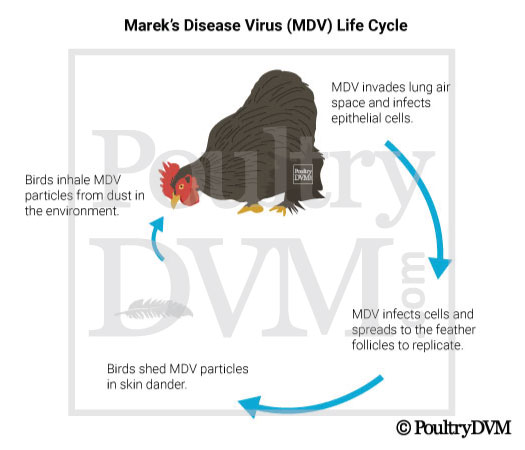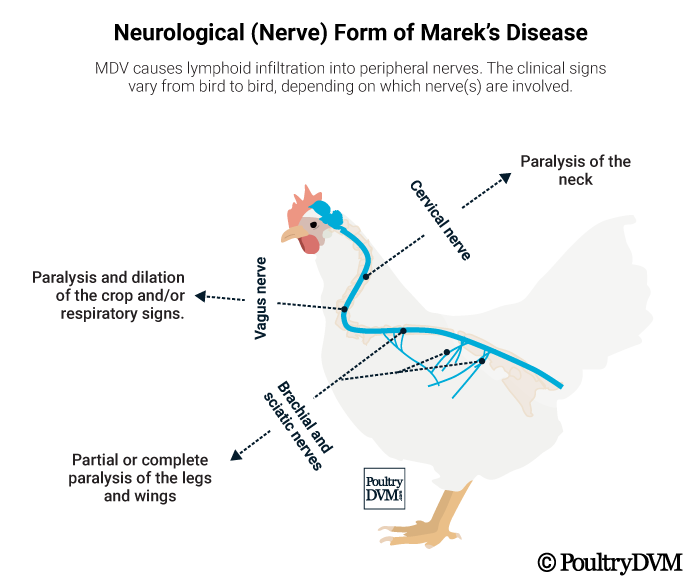Marek’s Disease (MD) is a common, highly contagious tumor-causing viral infection which affects chickens and sometimes turkeys, worldwide. There are many different strains of the virus, which vary in pathogenicity from non-pathogenic to highly virulent. Once a chicken is infected, they're infected for life. Although there is a vaccine available which is relatively effective against clinical disease from developing, it does not prevent the chicken from becoming infected and spreading the virus to other birds throughout their life span.
Marek's disease is characterized by peripheral nerve enlargement and development of visceral lymphomas that may affect a wide range of organs. The different forms of MD include the following:
- Neurological (nerve) form: Lymphoid infiltration into peripheral nerves. Clinical signs depend on which nerves are involved. Cervical nerve involvement causes wry neck, flaccid neck paralysis, and head tilt. When the vagus nerve is affected, the bird may have crop emptying issues and/or breathing difficulty. Occurs commonly; mortality up to 20%.
- Transient paralysis (TD): Vasogenic brain edema; causes temporary incoordination (ataxia), partial to complete paralysis of the neck or legs, lasting only 1 to 2 days. Occurs occasionally; mortality up to 30%.
- Ocular (eye) form: Lymphoid infiltration into eyes; causes change in iris color, pupil shape or size, partial or total blindness. Rare, occurs usually in older birds; mortality up to 25%.
- Cutaneous (skin) form: Lymphoid infiltration into skin; causes enlarged feather follicles, often scattered or clustered together, especially on the legs. Occurs commonly; 0% morality rate.
- Visceral (internal) form: Tumors develop on internal organs (kidneys, spleen, liver, gonads, heart, and proventriculus). Clinical signs vary based on the location of the tumors. Occurs very commonly; 60-80% mortality rate.
How Chickens Become Infected with the Marek's Disease Virus
Chickens become infected with MDV by inhaling infected dust and dander shed in the form of flakes of the skin of infected birds. Once inhaled, the virus invades the chicken's lung air space and infects epithelial cells, and spreads to other cells throughout the body. Similar to other herpes viruses, MDV has a tendency to be transported towards cutaneous sites such as the skin, and feather follicles. From there, MDV is shed into the environment via scales and feather debris from infected birds. The virus can remain infectious in the environment for up to 8 months.

The presence of maternal antibody against MD can protect baby chicks, and with the development of a functional immune system, a degree of resistance to MD is developed. However, husbandry-related stress, or concurrent infection with other immunosuppressive pathogens will significantly enhance their susceptibility to developing clinical disease. The percentage of clinically sick birds in a flock depends on the strain of virus and the breed of bird. The percentage of birds in a flock who are infected and develop clinical signs of disease can be anywhere from 1% to up to 50%. The clinical disease is usually seen in unvaccinated chickens between 6 weeks to 30 weeks of age. But the disease occurs in older birds as well.
Marek's disease can be confirmed in unvaccinated birds by sending a couple of the bird's feathers to a veterinary diagnostic laboratory for confirmation. If the chicken has already died, sending their body to a diagnostic lab for a necropsy and examination of the tumorous tissues is the best option.
Chickens vaccinated against Marek’s disease rarely get sick. However, they must have received the vaccine before they are exposed to the virus. Then the birds need about 4-14 days for the vaccine to start to become effective. There are different types of the vaccine available, and some are more effective, and require more lead time to work than others.
Any birds who have not received the MD vaccine should never be combined with any chickens who have been vaccinated. This is because the vaccine prevents the formation of tumors, but it does not prevent the chicken from getting infected and spreading the virus to other birds.


